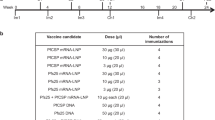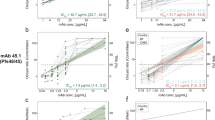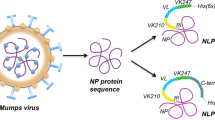Abstract
Malaria is one of the most important parasitic diseases of man. Efforts to reduce the prevalence and continued geographic spread of this disease by chemotherapy and spraying with insecticides to eradicate the mosquito vector have been hindered by the emergence of resistant strains of both parasite and vector. Recent advances in the identification and characterization of antigens associated with different stages of the parasite life cycle offer new opportunities for vaccination as a strategy for disease control. This article surveys current knowledge of the properties of candidate antigens for stage-specific malaria vaccines, describes progress in cloning the genes for these molecules and outlines current concepts regarding the feasibility of disease control by vaccination.
This is a preview of subscription content, access via your institution
Access options
Subscribe to this journal
Receive 12 print issues and online access
$209.00 per year
only $17.42 per issue
Buy this article
- Purchase on Springer Link
- Instant access to full article PDF
Prices may be subject to local taxes which are calculated during checkout
Similar content being viewed by others
References
Sturchler, D. 1984. Malaria prophylaxis in travellers: the current position. Experientia 40(12): 1357–1362.
Garnham, P.C.C. 1984. The present state of malaria research: an historical survey. Experientia 40(12): 1305–1310.
Perrin, L., Perez, A. and Chizzolini, C. 1984. Malaria: immunity, vaccination and immunodiagnosis. Experientia 40(12): 1343–1350.
Wernsdorfer, W.H. 1983. Urgent efforts needed to combat drug-resistant malaria. WHO Chronicle 37(1): 11–13.
Doberstyn, E.B. 1984. Resistance of Plasmodium falciparum. Experientia 40: 1311–1317.
Aron, J.L. and May, R.M. 1982. The population dynamics of malaria, p. 139–179. In: Population Dynamics of Infectious Diseases, Theory and Applications, Anderson, R. M. (ed.) Chapman and Hall.
Trager, W. and Jensen, J.B. 1976. Human malaria parasites in continuous culture. Science 193: 673–675.
Mitchell, G.H. 1984. Vaccination against malaria: its plausibility and the present state of research. Vaccine 2: 115–124.
Allison, A.C. 1984. Cellular immunity to malaria and babesia parasites: a personal viewpoint, p. 463–490 In: Contemporary Topics in Immunobiology Vol. 12, Immunobiology of Parasites and Parasitic Infections, Marchalonis, J. J. (ed.), Plenum Press
Molineaux, L. and Gramicia, G. 1980. The Garki Project: research on the epidemiology and control of malaria in the Sudan Savanna of West Africa. World Health Organisation, Geneva.
Kretschmar, W. and Voller, A. 1973. Suppression of Plasmodium falciparum malaria in Aotus monkeys by milk diet. Z Tropenmed. Parasitol. 24: 51–59.
Pasvol, G. et al. 1976. Foetal hoemoglobin and malaria. Lancet i: 1269–1272.
Perrin, L.H. Rodriguez da Silva, L. and Dayal, R. 1984. Antigenic characterization of plasmodia, p. 109–125. In: Contemporary Topics in Immunobiology Vol. 12, Immunobiology of Parasites and Parasitic Infections, Marchalonis, J.J. (ed.), Plenum Press.
Howard, R.J. and Barnwell, J.W. 1984. Roles of surface antigens on malaria-infected red blood cells in evasion of immunity, p. 127–200. In: Contemporary Topics in Immunobiology Vol. 12, Immunobiology of Parasites and Parasitic Infections, Marchalonis, J. J. (ed.), Plenum Press
Shortt, H.E., Pardit, S.R., Menon, K.P. and Swaminath, C. 1938. Absence of effective immunity after cure of protozoal infections. Indian J. Med. Res. 25: 763–777.
Klein, G. and Klein, E. 1985. Evolution of tumours and the impact of molecular oncology. Nature 315: 190–195.
Miller, L.H. 1985. Research toward a malaria vaccine: a critical review, p. 1–5. In: Vaccines 85, Molecular and Chemical Basis of Resistance to Parasitic, Bacterial, and Viral Diseases, Lerner, R. A., Chanock, R. M. and Brown, F. (eds.), Cold Spring Harbor Laboratory.
Miller, L.H., David, P.H. and Hadley, T.J. 1984. Perspectives for malaria vaccination. Phil. Trans. Roy. Soc. London 307: 99–108.
Wery, M., Weyn, J., Timperman, A. and Hendrix, L. 1979. Observations on the virulence and the antigenic characters of clones and uncloned lines of the Anka isolate of Plasmodium berghei. 1. Production of recrudescent parasitemias in immunized mice. Ann. Soc. Belge. Med. Trop. 59: 347–360.
Knowles, G. and Walliker, D. 1980. Variable expression of virulence in the rodent malaria Plasmodium yoelii yoelii. Parasitology 81: 211–219.
Hommel, M., David, P.H. and Oligino, L.D. 1983. Surface alterations of erythrocytes in Plasmodium falciparum malaria. J. Exp. Med. 157: 1137–1148.
David, P.H. et al. 1985. Immunization of monkeys with a 140 kilodalton merozoite surface protein of plasmodium knowlesi malaria: appearance of alternate forms of this protein. J. Immunology 134(6): 4146–4152.
Yoshida, N. et al. 1980. Hybridoma produces protective antibodies directed against the sporozoite stage of malaria parasites. Science 207: 71–73.
Nussenszweig, R.S., Vanderberg, J. and Most, H. 1969. Protective immunity produced by the injection of X-irradiated sporozoites of Plasmodium berghei IV. Dose response, specificity and humoral immunity. Mil. Med. (suppl.) 134: 1176–1182.
Zavala, R. et al. 1983. Circumsporbzoite proteins of malaria parasites contain a single immunodominant region with two or more identical epitopes. J. Exp. Med. 157: 1947–1957.
Potocnaj, P., Yoshida, N., Nussenzweig, R.S. and Nussenzweig, V. 1980. Monovalent fragments (Fab) of monoclonal antibodies to sporozoite surface antigen (Pb44) protect mice against malarial infection. J. Exp. Med. 151: 1504–1513.
Clyde, D.F., Most, H., McCarthy, V. and Vanderberg, J.P. 1973. Immunization of man against sporozoite induced falciparum malaria. Amer. J. Med. Sci. 266: 166–177.
Ellis, J. et al. 1983. Cloning and expression in E . coli of the malaria sporozoite surface antigen gene from Plasmodium knowlesi. Nature 302: 536–538.
Ozaki, L.S. et al. 1983. Structure of the Plasmodium knowlesi gene coding for the circumsporozoite protein. Cell 34: 815–822.
Sharma, S. et al. 1985. Diversity of CS-genes from two different strains of the malarial parasite P . knowlesi. Science, in press.
Enea, V. et al. 1984. Circumsporozoite gene of Plasmodium cynomolgi (Gombak): cDNA cloning and expression of the repetitive circumsporozoite epitope. Proc. Natl. Acad. Sci. USA 81: 7520–7524.
Cochrane, A.H. et al. 1985. Mol. Biochem. Parasitol. 14: 111–124.
Zavala, F., Masuda, A. and Nussenzweig, R.S. 1984. Species specific epitope is identical in phenotypically different circumsporozoite proteins of human malaria. Fedn Proc. Fedn Am. Socs Exp. Biol. 43: 1808.
Dame, J.B. et al. 1984. Structure of the gene encoding the immuno-dominant surface antigen on the sporozoite of the human malaria parasite Plasmodium falciparum. Science 225: 593–599.
Enea, V. et al. 1984. DNA cloning of Plasmodium falciparum circumsporozoite gene: amino acid sequence of repetitive epitope. Science 25: 628–630.
Ballou, W.R. et al. 1985. Immunogenicity of synthetic peptides from circumsporozoite protein of Plasmodium falciparum. Science 228: 996–999.
Vergara, V. et al. 1985. Conserved group-specific epitopes of the circumsporozoite proteins revealed by antibodies to synthetic peptides. J. Immunol. 134: 3445–3448.
Young, J.F. et al. 1985. Expression of P. falciparum circumsporozoite protein derivatives in E. coli for development of a human malaria vaccine. Science 228: 958–962.
Zavala, F. et al. 1985. Rationale for the development of a synthetic vaccine against P. falciparum malaria. Science, in press.
Ballou, W.P. 1985. Immunogenicity of synthetic peptides from circumsporozoite protein of Plasmodium falciparum. Science 228: 996–999.
Smith, G.L. et al. 1984. Expression of antigenic and immunogenic Plasmodium knowlesi circumsporozoite protein by an infectious vaccinia virus recombinant. Science 224: 397–399.
Smith, G.L. and Moss, B. 1984. Vaccinia virus expression vectors: construction, properties and applications. Biotechniques 306–312.
Cohen, S., McGregor, I.A. and Carrington, S.C. 1961. Gamma globulin and acquired immunity to human malaria. Nature 192: 733–737.
Miller, L.H., McAuliffe, F.M. and Mason, S.J. 1977. Erythrocyte receptors for malaria merozoites. Am. J. Trop. Med. Hyg. 26: 204–208.
Aikawa, M., Miller, L.H., Johnson, J. and Rabbege, J. 1978. Erythrocyte entry by malaria merozoites. A moving junction between erythrocyte and parasite. J. Cell. Biol. 77: 72–82.
Perlmann, H. et al. 1984. Antibodies in malarial sera to parasite antigens on the surface of erythrocytes infected with early asexual stages of Plasmodium falciparum. J. Exp. Med. 159: 1686–1704.
Kilejian, A. 1979. Characterization of a protein correlated with the production of knob-like protrusions on membranes of erythrocytes infected with Plasmodium falciparum. Proc. Natl. Acad. Sci. USA 76: 4650–4653.
Luse, S.A. and Miller, L.H. 1971. Plasmodium falciparum malaria. Ultrastructure of parasitized erythrocytes in cardiac vessels. Am. J. Trop. Med. Hyg. 20: 655–660.
Miller, L.H. et al. 1977. Evidence for differences in erythrocyte surface receptors for the malarial parasites, Plasmodium falciparum and Plasmodium knowlesi. J. Exp. Med. 146: 277–281.
Pasvol, G., Wainscoat, J.S.A. and Weatherall, D.J. 1982. Erythrocytes deficient in glycophorin resist invasion by the malarial parasite Plasmodium falciparum. Nature 297: 64–66.
Perkins, M.E. 1984. Binding of glycophorins to P. falciparum merozoites. Mol. Biochem. Parasitol. 10: 67–78.
Perkins, M.E. 1981. Inhibitory effects of erythrocyte membrane proteins on the in vitro invasion of the human malarial parasite Plasmodium falciparum into its host cell. J. Cell Biol. 90: 563–567.
Perkins, M.E. 1984. Surface proteins of Plasmodium falciparum merozoites binding to the erythrocyte receptor, glycophorin. J. Exp. Med. 160: 788–798.
Ravetch, J.V., Kochan, J. and Perkins, M.E. 1985. Isolation of the gene for a glycophorin-binding protein implicated in erythrocyte invasion by a malaria parasite. Science 227: 1593–1597.
Kemp, D.J. et al. 1983. Expression of Plasmodium falciparum blood-stage antigens in E. coli: detection with antibodies from immune humans. Proc. Natl. Acad. Sci. USA 80: 3787–3791.
Koenen, M. et al. 1984. Human antisera detect a Plasmodium falciparum genomic clone encoding a nonapeptide repeat. Nature 311: 789–792.
Ardeshir, F., Flint, J.E. and Reese, R.T. 1985. Expression of P. falciparum surface antigens in E. coli. Proc. Natl. Acad. Sci. USA 82: 2518–2522.
Holder, A.A. and Freeman, R.R. 1982. Biosynthesis and processing of a Plasmodium falciparum schizont antigen recognized by immune serum and monoclonal antibody. J. Exp. Med. 156: 1528–1538.
Perkins, M. 1982. Surface proteins of schizont-infected erythrocytes and merozoites of Plasmodium falciparum. Mol. Biochem. Parasitol. 5: 55–64.
Hall, R. et al. 1983. Antigens of the erythrocytic stages of the human malaria parasite Plasmodium falciparum detected by monoclonal antibodies. Mol. Biochem. Parasitol. 7: 247.
Pirson, P.J. and Perkins, M.E. 1985. Characterization with monoclonal antibodies of a surface antigen of Plasmodium falciparum merozoites. J. Immunol. 134: 1946–1951.
Hall, R. et al. 1984. Processing, polymorphism and biological significance of p190, a major surface antigen of the erythrocytic forms of Plasmodium falciparum. Mol. Biochem. Parasitol. 11: 61–80.
David, P.H., Hadley, T.J., Aikawa, M. and Miller, L.H. 1984. Processing of a major surface glycoprotein occurs during the ultimate stages of differentiation in Plasmodium knowlesi malaria. Mol. Biochem. Parasitol. 11: 267–282.
Holder, A.A. and Freeman, R.R. 1981. Immunization against blood stage rodent malaria using purified parasite antigens. Nature 294: 361–364.
Perrin, L.H. et al. 1984. Antimalarial immunity in Saimiri monkeys: Immunization with surface components of asexual blood stages. J. Exp. Med. 160: 441–451.
Hall, R. et al. 1984. Major surface antigen gene of a human malaria parasite cloned and expressed in bacteria. Nature 311: 379–382.
Odink, K.G. et al. 1984. Expression of cloned cDNA for a major surface antigen of Plasmodium falciparum merozoites. FEBS Lett. 173: 108–112.
Cheung, A., Sharv, A.R., Leban, J. and Perrin, L.H. 1985. Cloning and Expression in E. coli of a surface antigen of Plasmodium falciparum merozoites. EMBO J.. 4: 1007–1012.
Coppel, R.L. et al. 1983. Isolate specific S antigen of Plasmodium falciparum contains a repeated sequence of eleven amino acids. Nature 306: 751–756.
Wilson, R.J.M. et al. 1969. Lancet ii: 201–205.
Cowman, A.F. et al. 1985. Conserved sequences flank variable tandem repeats in two S-antigen genes of Plasmodium falciparum. Cell 40: 775–783.
Perrin, L.H., Ramirez, E., Lambert, P.H. and Miescher, P.A. 1981. Inhibition of P. falciparum growth in human erythrocytes by monoclonal antibodies. Nature 289: 301–303.
Newbold, C. 1984. Mol. Biochem. Parasitol. 11: 1–22.
Jensen, J.B. et al. 1983. Association between human serum-induced crisis forms in cultured P. falciparum and clinical immunity to malaria in Sudan. Infect. Immun. 41: 1302, 1300.
Huff, C.G., Marchbank, D.F. and Shiroishi, T. 1958. Changes in infectiousness of malarial gametes. II. Analysis of the possible causative factors. Exp. Parasitol. 7: 399–417.
Gwadz, R.W. 1976. Malaria: successful immunization against the sexual stages of Plasmodium gallinaceum. Science 193: 1150–1151.
Carter, R. and Chen, D.H. 1976. Malaria transmission blocked by immunization with gametes of the malaria parasite. Nature 263: 57–60.
Carter, R. et al. 1984. Target antigens in malaria transmission blocking immunity. Phil. Trans. R. Soc. Lond. 307: 201–213.
Rener, J. et al. 1983. Target antigens of transmission blocking immunity on gametes of Plasmodium falciparum. J. Exp. Med. 158: 976–981.
Kaushal, D.C. et al. 1983. Monoclonal antibodies against surface determinants on gametes of Plasmodium gallinaceum block transmission of malaria parasites to mosquitoes. J. Immunol. 131: 2557–2562.
Carter, R. and Kaushal, D.C. 1984. Characterization of antigens on mosquito midgut stages of Plasmodium gallinaceum. III. Changes in zygote surface proteins during transformation to mature ookinete. Mol. Biochem. Parasitol. 13: 235–241.
Schwartz, D.C. and Cantor, C.R. 1984. Separation of yeast chromosome-sized DNAs by pulsed field gel electrophoresis. Cell 37: 67–75.
Kemp, D.J. et al. 1985. Size variation in chromosomes from independent cultured isolates of Plasmodium falciparum. Nature 315: 347–350.
Van de Ploeg, L.H.T. et al. 1985. Science, in press.
Coppel, R.L. 1984. Immune sera recognize on erythrocytes a Plasmodium falciparum antigen composed of repeated amino acid sequences. Nature 310: 789–792.
Stahl, H.D. et al. 1985. Interspersed blocks of repetitive and charged amino acids in a dominant immunogen of Plasmodium falciparum. Proc. Natl. Acad. Sci. USA 82: 543–547.
Anderson, R.M. (ed.) 1982. Population Dynamics of Infectious Diseases, Theory and Applications, Chapman and Hall.
Anderson, R.M. and May, R.M. (eds.) 1982. Population Biology of Infectious Diseases, Springer-Verlag Berlin, Heidelberg, New York.
Ross, R. 1904. On the logical basis of the sanitary policy of mosquito reduction. Proceedings of the Congress, Arts, Science, St. Louis, U.S.A. 6: 89. (Also (1905) British Medical Journal 1: 1025–1029).
Ross, R. 1911. The prevention of malaria (2nd ed.), Murray, London.
Macdonald, G. 1952. The analysis of equilibrium in malaria. Tropical Diseases Bulletin, 49: 813–828.
Macdonald, G. 1957. The epidemiology and control of malaria. Oxford University Press, London.
Bradley, D.J. 1982. Epidemiological models—theory and reality, p. 320–361 In: Population Dynamics of Infectious Diseases, Theory and Applications, Anderson, R.M. (ed.). Chapman and Hall.
Molineaux, L., Storey, J., Cohen, J.E. and Thomas, A. 1982. A longitudinal study of human malaria in the West African savanna in the absence of control measures: relationships between P. falciparum and P. malariae. Am. J. Tropical and Medical Hygiene 29: 725–737.
Dietz, K. 1980. Models for vector-borne parasitic diseases. Lecture Notes in Biomathematics 39: 264–277.
Anderson, R.M. 1982. Transmission dynamics and control of infectious disease agents, p. 149–176. In: Population Biology of Infectious Diseases, Anderson, R.M., and May, R.M. (eds.). Springer-Verlag.
Dietz, K. 1982. Overall population patterns in the transmission cycle of infectious disease agents, p. 87–102. In: Population Biology of Infectious Diseases, Anderson, R.M. and May, R.M. (eds.). Springer Verlag.
Author information
Authors and Affiliations
Rights and permissions
About this article
Cite this article
Ravetch, J., Young, J. & Poste, G. Molecular Genetic Strategies for the Development of Anti-Malarial Vaccines. Nat Biotechnol 3, 729–740 (1985). https://doi.org/10.1038/nbt0885-729
Issue Date:
DOI: https://doi.org/10.1038/nbt0885-729
This article is cited by
-
Effects of fermentation feeding strategies prior to induction of expression of a recombinant malaria antigen inEscherichia coli
Journal of Industrial Microbiology (1987)



